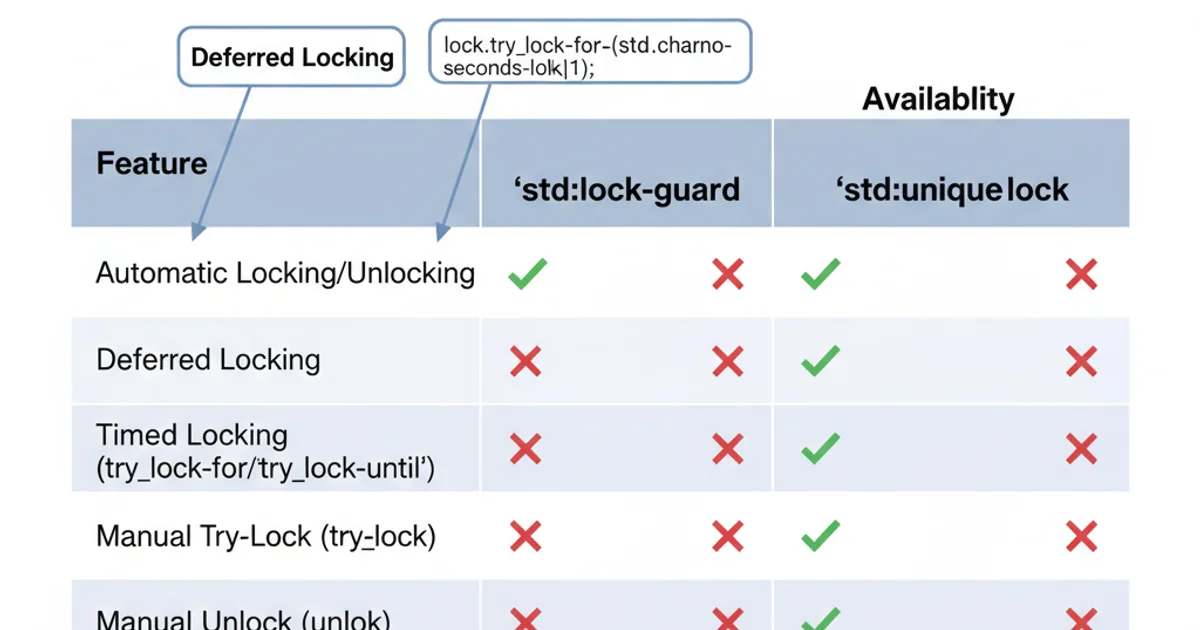std::unique_lock<std::mutex> or std::lock_guard<std::mutex>?
Categories:
std::unique_lockstd::mutex vs. std::lock_guardstd::mutex: Choosing the Right Lock

Understand the key differences between std::unique_lock and std::lock_guard in C++ for thread synchronization and learn when to use each for optimal performance and flexibility.
In concurrent C++ programming, protecting shared resources from race conditions is paramount. The C++ Standard Library provides several synchronization primitives, with std::mutex being the fundamental building block. To manage the locking and unlocking of a std::mutex safely and idiomatically, you typically use RAII (Resource Acquisition Is Initialization) wrappers like std::lock_guard and std::unique_lock. While both serve to acquire and release a mutex, they offer different levels of flexibility and overhead. This article will delve into their characteristics, use cases, and help you decide which one is appropriate for your specific needs.
std::lock_guard: Simplicity and Efficiency
std::lock_guard is a lightweight RAII wrapper for mutexes. Its primary purpose is to provide automatic locking and unlocking of a mutex within a scope. When a std::lock_guard object is created, it attempts to lock the associated mutex. When the std::lock_guard object goes out of scope (either normally or due to an exception), its destructor is called, which automatically unlocks the mutex. This ensures that the mutex is always released, preventing deadlocks and simplifying error handling.
#include <iostream>
#include <mutex>
#include <thread>
std::mutex mtx;
int shared_data = 0;
void increment_with_lock_guard() {
std::lock_guard<std::mutex> lock(mtx); // Locks mtx
shared_data++;
std::cout << "Incremented to: " << shared_data << std::endl;
} // mtx is automatically unlocked here when lock goes out of scope
int main() {
std::thread t1(increment_with_lock_guard);
std::thread t2(increment_with_lock_guard);
t1.join();
t2.join();
return 0;
}
Basic usage of std::lock_guard for protecting shared data.
std::lock_guard is non-copyable and non-movable. This design choice reinforces its RAII nature, ensuring that the ownership of the lock is strictly tied to its scope.std::unique_lock: Flexibility and Advanced Control
std::unique_lock is a more flexible RAII wrapper for mutexes compared to std::lock_guard. While it also provides automatic locking and unlocking, it offers additional features that allow for more fine-grained control over the mutex's state. These features include deferred locking, timed locking, try-locking, and the ability to transfer ownership of the lock.
#include <iostream>
#include <mutex>
#include <thread>
#include <chrono>
std::mutex mtx_unique;
int shared_resource = 0;
void process_resource_with_unique_lock() {
std::unique_lock<std::mutex> lock(mtx_unique, std::defer_lock); // Deferred locking
// Perform some work before locking
std::this_thread::sleep_for(std::chrono::milliseconds(50));
lock.lock(); // Explicitly lock the mutex
shared_resource++;
std::cout << "Processed resource: " << shared_resource << std::endl;
// lock.unlock(); // Can explicitly unlock before scope ends if needed
} // mtx_unique is automatically unlocked here if still locked
int main() {
std::thread t1(process_resource_with_unique_lock);
std::thread t2(process_resource_with_unique_lock);
t1.join();
t2.join();
return 0;
}
Using std::unique_lock with deferred locking for more control.
std::unique_lock is movable but not copyable. This allows for transferring ownership of the lock, which is crucial for implementing more complex synchronization patterns, such as passing a lock to a condition variable.Key Differences and When to Use Which
The choice between std::lock_guard and std::unique_lock boils down to the specific requirements of your synchronization logic. std::lock_guard is simpler, has less overhead, and should be your default choice when you need a mutex to be locked for the entire duration of a scope. std::unique_lock provides more features but comes with a slightly higher performance cost due to its added flexibility. The following diagram illustrates the decision-making process.
flowchart TD
A[Start: Need to protect shared resource?] --> B{Lock for entire scope?}
B -->|Yes| C[Use std::lock_guard]
B -->|No| D{Need advanced features?}
D -->|Yes| E[Use std::unique_lock]
D -->|No| F[Re-evaluate synchronization needs]
E --> G{Features needed?}
G --> H[Deferred Locking]
G --> I[Timed Locking (try_lock_for/until)]
G --> J[Manual Unlock/Relock]
G --> K[Transfer Ownership (e.g., with condition_variable)]
C --> L[End]
F --> L[End]
H --> L[End]
I --> L[End]
J --> L[End]
K --> L[End]Decision flow for choosing between std::lock_guard and std::unique_lock.
std::unique_lock offers manual lock() and unlock() methods, relying on them too heavily can negate the benefits of RAII and introduce opportunities for errors. Always prefer RAII-based locking unless a specific advanced feature of std::unique_lock is genuinely required.Summary of Features
Here's a quick comparison of the features offered by both lock types:

Feature comparison: std::lock_guard vs. std::unique_lock